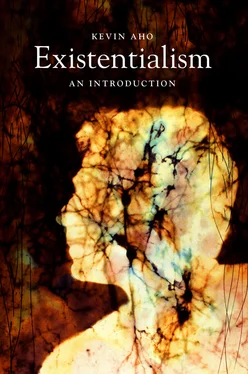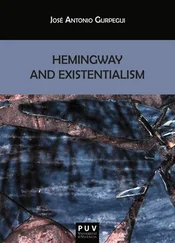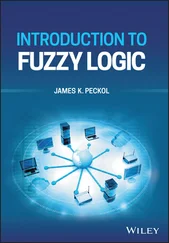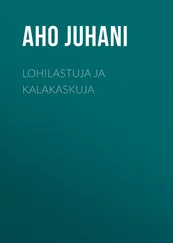Kevin Aho - Existentialism - An Introduction
Здесь есть возможность читать онлайн «Kevin Aho - Existentialism - An Introduction» весь текст электронной книги совершенно бесплатно (целиком полную версию без сокращений). В некоторых случаях можно слушать аудио, скачать через торрент в формате fb2 и присутствует краткое содержание. Год выпуска: 2013, ISBN: 2013, Издательство: Polity, Жанр: Философия, на английском языке. Описание произведения, (предисловие) а так же отзывы посетителей доступны на портале библиотеки ЛибКат.
- Название:Existentialism: An Introduction
- Автор:
- Издательство:Polity
- Жанр:
- Год:2013
- ISBN:978-0745651422
- Рейтинг книги:3 / 5. Голосов: 1
-
Избранное:Добавить в избранное
- Отзывы:
-
Ваша оценка:
- 60
- 1
- 2
- 3
- 4
- 5
Existentialism: An Introduction: краткое содержание, описание и аннотация
Предлагаем к чтению аннотацию, описание, краткое содержание или предисловие (зависит от того, что написал сам автор книги «Existentialism: An Introduction»). Если вы не нашли необходимую информацию о книге — напишите в комментариях, мы постараемся отыскать её.
Existentialism: An Introduction
Existentialism: An Introduction — читать онлайн бесплатно полную книгу (весь текст) целиком
Ниже представлен текст книги, разбитый по страницам. Система сохранения места последней прочитанной страницы, позволяет с удобством читать онлайн бесплатно книгу «Existentialism: An Introduction», без необходимости каждый раз заново искать на чём Вы остановились. Поставьте закладку, и сможете в любой момент перейти на страницу, на которой закончили чтение.
Интервал:
Закладка:
Merleau-Ponty offers an alternative to Heidegger's historicism, by arguing that being-in-the-world is grounded not only in the meanings and values of a particular historical tradition, but in a prior “visual, auditory, and tactile field” (1962, 353) that is already opened up by the perceptual activity of the lived body. On Merleau-Ponty's account, beneath the prejudices of our shared history, there is a dimension of bodily experience that is ‘pre-personal,’ that is prior to language, culture, and thought, revealing that I am “already in communication with others” (353) because I am bound up in an inter-human web of feelings, gestures, and affective expressions, and this relational web can provide its own moral orientation.
Intercorporeality
By interpreting the individual in terms of ‘intercorporeality,’ Merleau-Ponty not only unsettles the notion of the sovereign subject, he also invests being-in-the-world with a moral dimension by revealing how we can recognize and feel our way into the lives of others through shared bodily experience. Again, for Merleau-Ponty, the body is not an encapsulated object that exists mechanistically as ‘ partes extra partes .’ It refers to the feelings, perceptions, and movements of ‘ my own body ’ ( le corps propre ), the body that I am enacting and living through in my everyday life. From this perspective, my being does not end with my own skin because it is already stretching into a shared world, weaving its way into familiar patterns of behavior and recognizing the intentions, gestures, and expressions of others, and the threads of this embodied weave form an interconnected system. In Phenomenology of Perception , he explains,
I experience my own body as the power of adopting certain forms of behavior and a certain world, and I am given to myself merely as a certain hold upon the world; now, it is precisely my body which perceives the body of another, and discovers in that other body a miraculous prolongation of my own intentions, a familiar way of dealing with that world. Henceforth, as the parts of my body together compromise a system, so my body and the other's are one whole, two sides of one and the same phenomenon, and the anonymous existence of which my body is the ever-renewed trace henceforth inhabits both bodies simultaneously. (1962, 353–354)
It is through this ‘prolongation of my own intentions’ that I am able to recognize the other, not as an object that is separate and distinct from me, but as a being whose intentions and experiences overlap with mine because we are both bound together in familiar ways of bodily being-in-the-world. This is because, as a sentient and corporeal being, I am already woven into the world and in dialogue with others through my senses before I ever encounter others from the perspective of ‘subject’ and ‘object.’ In this sense, we are part of the same elemental tissue, or what Merleau-Ponty will later call ‘flesh.’ “My body is made of the same flesh as the world (it is perceived),” he writes, “and moreover … this flesh of my body is shared by the world, the world reflects it, encroaches upon it, and it encroaches upon the world. … They are in a relation of … overlapping” (1968, 248).
The recovery of this affective, pre-personal way of being opens up the possibility for a moral orientation, one where we do not interpret ourselves as sovereign subjects but as beings whose bodily fields are sensibly intertwined with those of others (see Levin 1999; Low 1994). This experience of intertwining or ‘chiasm’ allows us to recognize the pain and vulnerability of others because we embody these feelings in similar ways. Experiencing myself from this standpoint makes it possible to move beyond the prejudices of my own community, because I am able to encounter the other not as an outsider, but as a concrete individual who embodies his or her experience in ways that resemble my own and who shares the same elemental flesh as me. In this way, Merleau-Ponty offers a response to Heidegger's historicism and alleged antisemitism. In ‘The War Has Taken Place,’ he writes,
An anti-Semite could not stand to see Jews tortured if he really saw them, if he perceived that suffering and agony in an individual life — but this is just the point: he does not see Jews suffering; he is blinded by the myth of the Jew. He tortures and murders the Jew through these concrete beings; he struggles with dream figures, and his blows strike living faces. Anti-Semitic passion is not triggered by, nor does it aim at, concrete individuals. (2007, 44–45; cited in Levin 1999, 232)
The suggestion here is that when we ‘ really see ’ the other in all of their embodied concreteness, when we witness the affective tension in their posture, the tears welling up in their eyes, the horror or the joy in their face, we also witness ourselves. But this emotional recognition is not a product of “reasoning by analogy” (Merleau-Ponty 1962, 352), not a conscious objectification of others as material bodies that move and act as I do. It is, rather, an immediate experience of bodily co-presence, one where we live in the expressions, gestures, and movements of others. Merleau-Ponty uses the example of an infant mirroring the gestures of an adult to show how this primitive experience occurs and how it is anterior to self-consciousness and history. “A baby of fifteen months,” he writes, “opens its mouth if I playfully take its fingers between my teeth and pretend to bite it. And yet it has scarcely looked at its face in a glass, and its teeth are not in any case like mine. … ‘Biting’ has immediately, for it, an intersubjective significance. It perceives its intentions in its body, and my body with its own, and thereby my intentions in its own body” (352). For Merleau-Ponty, the infant, as a sentient being, is already in affective dialogue with the other and has a sense of the meaning of the other's acts, not by means of intellectually grasping them, but because there is an overlapping of bodily fields (Welsh 2007). In this web of mutual presence, the infant relates to and recognizes my feelings long before it can put words to them.
Interpreters such as David Michael Levin (1999) have pointed out how Merleau-Ponty's account of being-in-the-world not only offers an opening for a radical critique of the ideologies of individualism that prevail in modernity; it also opens up the possibility of recovering the moral dimension of bodily co-presence that constitutes the child's way of seeing. In this opening, as Levin writes, “I recognize myself as another for an other, and I am obliged to acknowledge that there are other perspectives. … Looking into the eyes of others, I may see myself; but what I should see is that I am exposed, vulnerable, held in their beholding” (228). Martin Buber will develop this notion of moral vision, agreeing that there is a primitive ‘bodily reciprocity’ that undermines the idea of the self as an encapsulated sovereign subject, and that when it comes to the immediate, pre-linguistic recognition of the other, the child has “more complete information” than I do (1970, 76). For Buber, this kind of recognition is sacred and constitutes the heart of what he calls the ‘I — Thou’ relation.
I and Thou
One of the consistent threads that run through the writings of religious existentialists like Dostoevsky, Marcel, Buber, and Levinas is a concern for how we treat others. These thinkers are united in their critique of modern society that they see as increasingly rationalistic and objectivizing, fostering a selfish and instrumental existence. Buber will refer to this as the ‘I–It’ attitude. In this attitude we tend to interpret ourselves as self-contained subjects that are detached from others. In this sense, it “erects a crucial barrier between subject and object” (1970, 75), reducing the other to a utilitarian thing to be manipulated and used for our own ends. What rises to the surface in this attitude are the self-centered, purposive, and materialistic concerns of my own ego. In this way, “the person beholds [only] his self; the ego occupies himself with his My: my manner, my race, my works, my genius” (114). It is important to note, however, that Buber does not regard the ‘I–It’ attitude as evil, nor does he deny the importance of selfishness or instrumental dealings with others. Such an attitude is essential for our survival; it gives our lives a measure of predictability and control and is central to the practical worlds of economics, finance, and manufacturing. The problem is that in the modern age, this attitude has come to dominate and block out any other way of relating to others, and consequently it denies us our essential humanity. This is why Buber says, “Without It a human being cannot live. But whoever lives only with that is not human” (85). Today, we are caught up in what Buber calls the “spell of separation” (125), where we see ourselves as autonomous, self-reliant individuals, who are independent from the rest of humanity, and this undermines the possibility of genuine community and reciprocal concern for each other. Dostoevsky offers a powerful description of this spell in The Brothers Karamazov :
Читать дальшеИнтервал:
Закладка:
Похожие книги на «Existentialism: An Introduction»
Представляем Вашему вниманию похожие книги на «Existentialism: An Introduction» списком для выбора. Мы отобрали схожую по названию и смыслу литературу в надежде предоставить читателям больше вариантов отыскать новые, интересные, ещё непрочитанные произведения.
Обсуждение, отзывы о книге «Existentialism: An Introduction» и просто собственные мнения читателей. Оставьте ваши комментарии, напишите, что Вы думаете о произведении, его смысле или главных героях. Укажите что конкретно понравилось, а что нет, и почему Вы так считаете.












